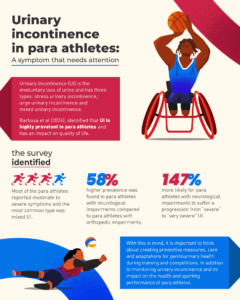Authors: Pê Barbosa and Marília Magno; Proofreading: Beatriz Bastos; Infographics: Oficina de Criação da Faculdade de Comunicação da Universidade Federal do Pará.
This blog provides an overview of a recently published paper in BJSM.
Why is this study important?
Urinary incontinence (UI) is characterised by the involuntary loss of urine. There are different types:
- Stress urinary incontinence – when urine is lost when performing an action that increases intra-abdominal pressure, such as coughing, sneezing or during physical activity
- Urge urinary incontinence – which is characterised by urinary loss in an episode of urinary urgency, such as losing urine before reaching the toilet
- Mixed urinary incontinence – when there are symptoms of both.
Currently, UI is prevalent in female athletes, with data ranging from 20% to 50% of any age and parity, reaching 40% in younger athletes that have not had any children. In male athletes, the prevalence of UI is 14.7%. Even though research into UI is increasing in athletes, there is still no data on these symptoms in para athletes, which is important for assessing the care needed to support the health of this group.
How did the study go about this?
An online survey was carried out with Brazilian parathletes, whose main evaluation tool was the International Consultation Questionnaire Urinary Incontinence Short Form (ICIQ-UI SF) to assess the presence of symptoms and characteristics of urinary incontinence.
What did the study find?
UI was found to be highly prevalent in para athletes and to have an impact on quality of life. Most of the para athletes reported moderate to severe symptoms and the most common type was mixed UI. Based on the study’s analyses, para athletes with neurological impairments had a 58% higher prevalence than para athletes with orthopaedic impairments. Para athletes with neurological impairments were 147% more likely to suffer a progression from “severe” to “very severe” UI.
What are the key take-home points?
This study is a great motivator for us to create preventive measures, attention, care and adaptations during training and competitions, for genitourinary health and monitoring of urinary incontinence and its impact on the health and sports performance of para athletes. Treatment of UI in para athletes include; physiotherapy and pelvic floor muscle training, guidance on water intake to avoid dehydration and overheating, taking breaks during training for bladder catheterisation and urination. It is worth noting that such care should be the initiative of sports organizations, aimed at coaches and healthcare providers through training, as well as actions and instructions for these para athletes

References
Huebner M, Ma W, Harding S. Sport-related risk factors for moderate or severe urinary incontinence in master female weightlifters: A cross-sectional study. PLoS One [Internet]. 2022 Nov 1;17(11):e0278376. Available from: https://journals.plos.org/plosone/article?id=10.1371/journal.pone.0278376
Gan ZS, Smith AL. Urinary Incontinence in Elite Female Athletes. Curr Urol Rep [Internet]. 2023 Feb 1;24(2):51–8. Available from: https://pubmed.ncbi.nlm.nih.gov/36418531/
Barbosa PN, Rodrigues MP, Costa e Silva ADA, et al. Prevalence of urinary incontinence in Brazilian para athletes. British Journal of Sports Medicine Published Online First: 03 June 2024. doi: 10.1136/bjsports-2024-108076